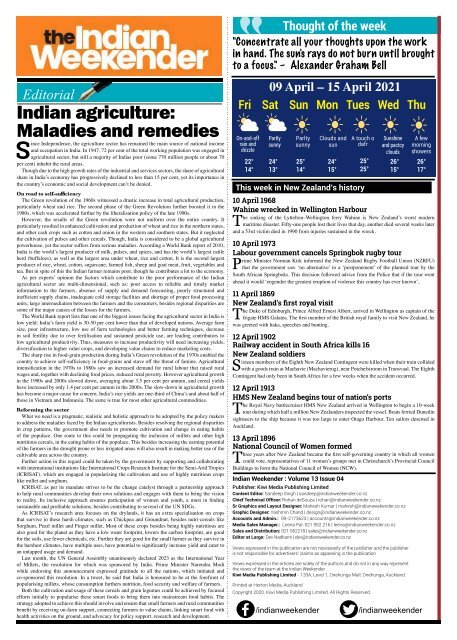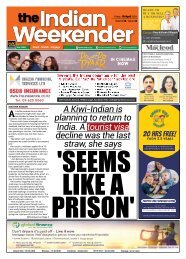The Indian Weekender, 9 April 2021
Weekly Kiwi-Indian publication printed and distributed free every Friday in Auckland, New Zealand
Weekly Kiwi-Indian publication printed and distributed free every Friday in Auckland, New Zealand
Create successful ePaper yourself
Turn your PDF publications into a flip-book with our unique Google optimized e-Paper software.
Editorial<br />
<strong>Indian</strong> agriculture:<br />
Maladies and remedies<br />
Since Independence, the agriculture sector has remained the main source of national income<br />
and occupation in India. In 1947, 72 per cent of the total working population was engaged in<br />
agricultural sector, but still a majority of Indias poor (some 770 million people or about 70<br />
per cent) inhabit the rural areas.<br />
Though due to the high growth rates of the industrial and services sectors, the share of agricultural<br />
share in India’s economy has progressively declined to less than 15 per cent, yet its importance in<br />
the country’s economic and social development can’t be denied.<br />
On road to self-sufficiency<br />
<strong>The</strong> Green revolution of the 1960s witnessed a drastic increase in total agricultural production,<br />
particularly wheat and rice. <strong>The</strong> second phase of the Green Revolution further boosted it in the<br />
1980s, which was accelerated further by the liberalisation policy of the late 1990s.<br />
However, the results of the Green revolution were not uniform over the entire country. It<br />
particularly resulted in enhanced cultivation and production of wheat and rice in the northern states,<br />
and other cash crops such as cotton and onion in the western and southern states. But it neglected<br />
the cultivation of pulses and other cereals. Though, India is considered to be a global agricultural<br />
powerhouse, yet the sector suffers from serious maladies. According a World Bank report of 2010,<br />
India is the world’s largest producer of milk, pulses, and spices, and has the world’s largest cattle<br />
herd (buffaloes), as well as the largest area under wheat, rice and cotton. It is the second largest<br />
producer of rice, wheat, cotton, sugarcane, farmed fish, sheep and goat meat, fruit, vegetables and<br />
tea. But in spite of this the <strong>Indian</strong> farmer remains poor, though he contributes a lot to the economy.<br />
As per experts’ opinion the factors which contribute to the poor performance of the <strong>Indian</strong><br />
agricultural sector are multi-dimensional, such as: poor access to reliable and timely market<br />
information to the farmers, absence of supply and demand forecasting, poorly structured and<br />
inefficient supply chains, inadequate cold storage facilities and shortage of proper food processing<br />
units, large intermediation between the farmers and the consumers, besides regional disparities are<br />
some of the major causes of the losses for the farmers.<br />
<strong>The</strong> World Bank report lists that one of the biggest issues facing the agricultural sector in India is<br />
low yield: India’s farm yield is 30-50 per cent lower than that of developed nations. Average farm<br />
size, poor infrastructure, low use of farm technologies and better farming techniques, decrease<br />
in soil fertility due to over fertilisation and sustained pesticide use, are leading contributors to<br />
low agricultural productivity. Thus, measures to increase productivity will need increasing yields,<br />
diversification to higher value crops, and developing value chains to reduce marketing costs.<br />
<strong>The</strong> sharp rise in food-grain production during India’s Green revolution of the 1970s enabled the<br />
country to achieve self-sufficiency in food-grains and stave off the threat of famine. Agricultural<br />
intensification in the 1970s to 1980s saw an increased demand for rural labour that raised rural<br />
wages and, together with declining food prices, reduced rural poverty. However agricultural growth<br />
in the 1990s and 2000s slowed down, averaging about 3.5 per cent per annum, and cereal yields<br />
have increased by only 1.4 per cent per annum in the 2000s. <strong>The</strong> slow-down in agricultural growth<br />
has become a major cause for concern. India’s rice yields are one-third of China’s and about half of<br />
those in Vietnam and Indonesia. <strong>The</strong> same is true for most other agricultural commodities.<br />
Reforming the sector<br />
What we need is a pragmatic, realistic and holistic approach to be adopted by the policy makers<br />
to address the maladies faced by the <strong>Indian</strong> agriculturists. Besides resolving the regional disparities<br />
in crop patterns, the government also needs to promote cultivation and change in eating habits<br />
of the populace. One route to this could be propagating the inclusion of millets and other high<br />
nutritious cereals, in the eating habits of the populace. This besides increasing the earning potential<br />
of the farmers in the drought prone or less irrigated areas will also result in making better use of the<br />
cultivable area across the country.<br />
Further action in this regard could be taken by the government by supporting and collaborating<br />
with international institutions like International Crops Research Institute for the Semi-Arid Tropics<br />
(ICRISAT), which are engaged in popularising the cultivation and use of highly nutritious crops<br />
like millet and sorghum.<br />
ICRISAT, as per its mandate strives to be the change catalyst through a partnership approach<br />
to help rural communities develop their own solutions and engages with them to bring the vision<br />
to reality. Its inclusive approach ensures participation of women and youth, a must in finding<br />
sustainable and profitable solutions, besides contributing to several of the UN SDGs.<br />
As ICRISAT’s research area focuses on the drylands, it has an extra specialisation on crops<br />
that survive in these harsh climates, such as Chickpea and Groundnut, besides nutri-cereals like<br />
Sorghum, Pearl millet and Finger millet. Most of these crops besides being highly nutritious are<br />
also good for the planet as they have a low water footprint, lowers the carbon footprint, are good<br />
for the soils, use fewer chemicals, etc. Further they are good for the small farmer as they survive in<br />
the harshest climates, have multiple uses, have potential to significantly increase yield and cater to<br />
an untapped usage and demand.<br />
Last month, the UN General Assembly unanimously declared 2023 as the International Year<br />
of Millets, the resolution for which was sponsored by India. Prime Minister Narendra Modi<br />
while endorsing this announcement expressed gratitude to all the nations, which initiated and<br />
co-sponsored this resolution. In a tweet, he said that India is honoured to be at the forefront of<br />
popularising millets, whose consumption furthers nutrition, food security and welfare of farmers.<br />
Both the cultivation and usage of these cereals and grain legumes could be achieved by focused<br />
efforts initially to popularise these smart foods to bring them into mainstream food habits. <strong>The</strong><br />
strategy adopted to achieve this should involve and ensure that small farmers and rural communities<br />
benefit by receiving on-farm support, connecting farmers to value chains, linking smart food with<br />
health activities on the ground, and advocacy for policy support, research and development.<br />
Thought of the week<br />
"Concentrate all your thoughts upon the work<br />
in hand. <strong>The</strong> sun's rays do not burn until brought<br />
to a focus." – Alexander Graham Bell<br />
<strong>Indian</strong> <strong>Weekender</strong> : Volume 13 Issue 04<br />
Publisher: Kiwi Media Publishing Limited<br />
Content Editor: Sandeep Singh | sandeep@indianweekender.co.nz<br />
Chief Technical Officer: Rohan deSouza | rohan@indianweekender.co.nz<br />
Sr Graphics and Layout Designer: Mahesh Kumar | mahesh@indianweekender.co.nz<br />
Graphic Designer: Yashmin Chand | design@indianweekender.co.nz<br />
Accounts and Admin.: 09-2173623 | accounts@indianweekender.co.nz<br />
Media Sales Manager.: Leena Pal: 021 952 216 | leena@indianweekender.co.nz<br />
Sales and Distribution: 021 952218 | sales@indianweekender.co.nz<br />
Editor at Large: Dev Nadkarni | dev@indianweekender.co.nz<br />
Views expressed in the publication are not necessarily of the publisher and the publisher<br />
is not responsible for advertisers’ claims as appearing in the publication<br />
Views expressed in the articles are solely of the authors and do not in any way represent<br />
the views of the team at the <strong>Indian</strong> <strong>Weekender</strong><br />
Kiwi Media Publishing Limited - 133A, Level 1, Onehunga Mall, Onehunga, Auckland.<br />
Printed at Horton Media, Auckland<br />
09 <strong>April</strong> – 15 <strong>April</strong> <strong>2021</strong><br />
Fri Sat Sun Mon Tues Wed Thu<br />
On-and-off<br />
rain and<br />
drizzle<br />
22°<br />
14°<br />
Partly<br />
sunny<br />
24°<br />
13°<br />
Parlty<br />
sunny<br />
25°<br />
14°<br />
Clouds and<br />
sun<br />
24°<br />
15°<br />
A touch o<br />
dafr<br />
This week in New Zealand’s history<br />
25°<br />
25°<br />
10 <strong>April</strong> 1968<br />
Wahine wrecked in Wellington Harbour<br />
Copyright 2020. Kiwi Media Publishing Limited. All Rights Reserved.<br />
Sunshine<br />
and pactcy<br />
clouds<br />
26°<br />
15°<br />
A few<br />
morning<br />
showers<br />
26°<br />
17°<br />
<strong>The</strong> sinking of the Lyttelton–Wellington ferry Wahine is New Zealand’s worst modern<br />
maritime disaster. Fifty-one people lost their lives that day, another died several weeks later<br />
and a 53rd victim died in 1990 from injuries sustained in the wreck.<br />
10 <strong>April</strong> 1973<br />
Labour government cancels Springbok rugby tour<br />
Prime Minister Norman Kirk informed the New Zealand Rugby Football Union (NZRFU)<br />
that the government saw ‘no alternative’ to a ‘postponement’ of the planned tour by the<br />
South African Springboks. This decision followed advice from the Police that if the tour went<br />
ahead it would ‘engender the greatest eruption of violence this country has ever known’,<br />
11 <strong>April</strong> 1869<br />
New Zealand's first royal visit<br />
<strong>The</strong> Duke of Edinburgh, Prince Alfred Ernest Albert, arrived in Wellington as captain of the<br />
frigate HMS Galatea. <strong>The</strong> first member of the British royal family to visit New Zealand, he<br />
was greeted with haka, speeches and bunting.<br />
12 <strong>April</strong> 1902<br />
Railway accident in South Africa kills 16<br />
New Zealand soldiers<br />
Sixteen members of the Eighth New Zealand Contingent were killed when their train collided<br />
with a goods train at Machavie (Machavierug), near Potchefstroom in Transvaal. <strong>The</strong> Eighth<br />
Contingent had only been in South Africa for a few weeks when the accident occurred.<br />
12 <strong>April</strong> 1913<br />
HMS New Zealand begins tour of nation’s ports<br />
<strong>The</strong> Royal Navy battlecruiser HMS New Zealand arrived in Wellington to begin a 10-week<br />
tour during which half a million New Zealanders inspected the vessel. Boats ferried Dunedin<br />
sightseers to the ship because it was too large to enter Otago Harbour. Ten sailors deserted in<br />
Auckland.<br />
13 <strong>April</strong> 1896<br />
National Council of Women formed<br />
Three years after New Zealand became the first self-governing country in which all women<br />
could vote, representatives of 11 women’s groups met in Christchurch’s Provincial Council<br />
Buildings to form the National Council of Women (NCW).


















